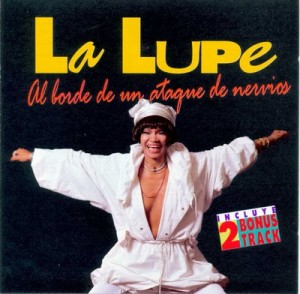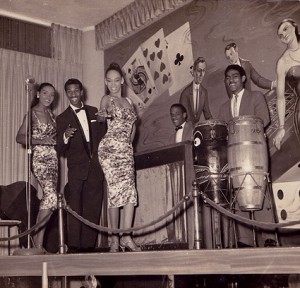La Lupe (born Guadalupe Victoria Yolí Raymond) (Santiago de Cuba, 23 December 1939 – The Bronx, New York, 29 February 1992), was a Cuban-American singer of several musical genres: boleros, guarachas and Latin soul in particular. Known for her energetic, sometimes controversial performances, she is considered by many to be one of the leading singers in the salsa music genre. She was born in the barrio of San Pedrito, Santiago de Cuba in 1939. She described her hometown as “so poor that no one knew it existed until I got famous.”
La Lupe was a singer of extraordinary talent. Her father was a worker at the local Bacardi distillery and a major influence on her early life. Her introduction to fame was in 1954, on a radio program which invited fans to sing imitations of their favorite stars. Lupe bunked off school to sing a bolero of Olga Guillot’s, called Miénteme (Lie to me), and won the competition. The family moved to Havana in 1955, where she was enrolled at the University of Havana to become a teacher. Like Celia Cruz, she was certified as a schoolteacher before she became a professional singer.
Lupe married in 1958 and formed a musical trio with her husband Eulogio “Yoyo” Reyes and another female singer. This group, Los Tropicuba, broke up along with the marriage in 1960. She began to perform her own act at a small nightclub in Havana, La Red (The Net), which had a clientele of distinguished foreigners. She acquired a devoted following, which included Ernest Hemingway, Tennessee Williams, Jean-Paul Sartre, Simone de Beauvoir and Marlon Brando[citation needed]. She also performed regularly on radio. She released her first album, Con el Diablo en el cuerpo (With the Devil in my body) in 1960, for RCA Victor, which was later certified gold. Her first television appearance on Puerto Rican television caused a stir due to her frenzied, vibrant performance, which reportedly shocked some viewers.
In 1962 she found herself exiled to the United States. In New York City she performed at a cabaret named La Barraca, where she was discovered by Mongo Santamaría and started a new career, making more than 10 records in five years. She married a second time, to salsa musician Willie García, with whom she had a daughter. That marriage also ended in divorce.
http://youtu.be/tQ-eNgcv0PQ
Lupe’s passionate performances covered the range of music: son montuno, bolero, boogaloo, venturing into other Caribbean styles like Dominican merengue, Puerto Rican bomba and plena. It was her recordings which brought Tite Curet Alonso into prominence as a composer of tough-minded boleros in the salsa style. In the 1960s she was the most acclaimed Latin singer in New York City due to her partnership with Tito Puente. She was the first Latin singer to sell out a concert event at Madison Square Garden. She covered a wide variety of cover versions in either Spanish or accented English, including Yesterday, Dominique by The Singing Nun, Twist & Shout, Unchained Melody, Fever and America from West Side Story.
The quality of her performances became increasingly uneven. There were pesistent rumours of her drug addiction, and her life was “a real earthquake” according to close friends. She ended some of her on-stage engagements being treated with an oxygen mask. Although she may have been poorly managed by her label Fania Records in particular, she managed and produced herself in mid-career, after she parted ways with Tito Puente.
“SI VUELVES TU” sings “LA LUPE”
A devout follower of Santería, she continued to practice her religion regardless of the influence, fortune, and fame she had acquired throughout the height of her career. Her record label, Fania Records, ended her contract in the late 1970s, perhaps simply because of falling sales. She retired in 1980, and found herself destitute by the early 1980s. In 1984 she injured her spine while trying to hang a curtain in her home; she initially used a wheelchair, then later a cane. An electrical fire made her homeless. After being “healed” at an evangelical Christian Crusade, La Lupe abandoned her Santería roots and became a born-again Christian. In 1991, she gave a concert at La Sinagoga in New York, singing Christian songs.
She died of a heart attack on 29 February 1992 at 52 years of age. She was survived by her second husband William García, son René Camaño (from her first marriage) and her daughter Rainbow García (from her second marriage). She’s interred in Saint Raymond’s Cemetery in the Bronx.
Her Story filmed:
http://youtu.be/-0O8VSfIsFo
Wiki / CubanMusicLupe / YouTube / InternetPhotos / TheCubanHistory.com
The Cuban History, Hollywood.
Arnoldo Varona, Editor.
LA EXCEPCIONAL CANTANTE “LA LUPE”.
La Lupe (Guadalupe Victoria Yoli nació Raymond) (Santiago de Cuba, 23 de diciembre de 1939 – El Bronx, Nueva York, 29 de febrero de 1992), fue una cantante cubano-americana de varios géneros musicales: boleros, guarachas y el alma de América en particular. Conocida por sus enérgicas actuaciones, a veces controvertidas, que es considerado por muchos como una de los cantantes más importantes del género de la música salsa. Ella nació en el barrio de San Pedrito en 1939. Ella describió su ciudad natal como “tan pobre que nadie sabía que existía hasta que se hizo famoso.”
La Lupe era un cantante de talento extraordinario. Su padre era un trabajador en el local de la destilería Bacardí y una gran influencia en su vida temprana. Su introducción a la fama fue en 1954, en un programa de radio que se invitó a los aficionados a cantar imitaciones de sus estrellas favoritas. Lupe escapamos del colegio para cantar un bolero de Olga Guillot, llamada Miénteme (Lie to me), y ganó el concurso. La familia se trasladó a La Habana en 1955, donde se matriculó en la Universidad de La Habana para convertirse en un maestro. Al igual que Celia Cruz, que fue certificado como maestro de escuela antes de convertirse en cantante profesional.
Lupe se casó en 1958 y formó un trío musical con su esposo, Eulogio “Yoyo” Reyes y otra cantante femenina. Este grupo, Los Tropicuba, rompió con el matrimonio en 1960. Ella comenzó a realizar su propio acto en un pequeño club nocturno en La Habana, La Red (The Net), que tenía una clientela de extranjeros distinguidos. Ella adquirió un devoto grupo de seguidores, que incluía a Ernest Hemingway, Tennessee Williams, Jean-Paul Sartre, Simone de Beauvoir y Marlon Brando [cita requerida]. Ella también se realizó regularmente en la radio. Ella lanzó su primer álbum, Con El Diablo En El Cuerpo (Con el diablo en mi cuerpo) en 1960, para el sello RCA Víctor, que fue certificado de oro más adelante. Su primera aparición en televisión en la televisión puertorriqueña causó un gran revuelo debido a su actuación frenética, vibrante, que al parecer sorprendió a algunos espectadores.
En 1962 se encontró exiliado en los Estados Unidos. En Nueva York actuó en un cabaret llamado La Barraca, donde fue descubierto por Mongo Santamaría y comenzó una nueva carrera, lo que hace más de 10 registros en cinco años. Se casó por segunda vez, al músico de salsa Willie García, con quien tuvo una hija. Que el matrimonio también terminó en divorcio.
http://youtu.be/tQ-eNgcv0PQ
Interpretaciones apasionadas de Lupe cubierto toda la gama de la música: el son montuno, el bolero, el boogaloo, aventurarse en otros estilos caribeños como el merengue dominicano, la bomba puertorriqueña y la plena. Fueron sus grabaciones que llevaron Tite Curet Alonso en la prominencia como un compositor de boleros obstinados en el estilo de la salsa. En la década de 1960 fue la cantante latina más aclamado en la ciudad de Nueva York debido a su asociación con Tito Puente. Fue el primer cantante latino de vender un concierto en el Madison Square Garden. Se cubrió una amplia variedad de versiones de la cubierta, ya sea en español o en Inglés con acento, como ayer, Dominique de The Singing Nun, Twist & Shout, Unchained Melody, La fiebre y los Estados Unidos de West Side Story.
La calidad de sus actuaciones se convirtió cada vez más desigual. Había persistentes rumores de su adicción a las drogas, y su vida era “un verdadero terremoto”, según amigos cercanos. Terminó algunos de sus compromisos en el escenario siendo tratada con una máscara de oxígeno. A pesar de que puede haber sido mal manejada por sus etiquetas de Fania Records, en particular, se las arregló y produjo ella misma en mitad de la carrera, después de que ella se separó de Tito Puente.
“SI VUELVES TU” canta “LA LUPE”
Una devota y seguidora de la santería, ella siguió practicando su religión, independientemente de la influencia, la fortuna y la fama que había adquirido a lo largo de la altura de su carrera. Su sello discográfico, Fania Records, terminó su contrato a finales de 1970, tal vez simplemente por la caída de las ventas. Se retiró en 1980, y se encontró la indigencia por la década de 1980. En 1984 se lesionó la columna vertebral al intentar colgar una cortina en su casa, que inicialmente se utilizó una silla de ruedas, luego un bastón Un incendio de origen eléctrico hizo su hogar.. Después de haber sido “curados” en una cruzada cristiana evangélica, La Lupe abandonó sus raíces santería y se convirtió en un cristiano nacido de nuevo. En 1991, ella dio un concierto en La Sinagoga en Nueva York, cantando canciones cristianas.
Ella murió de un ataque al corazón el 29 de febrero de 1992 a 52 años de edad. Ella fue sobrevivida por su segundo marido Guillermo García, el hijo de René Camaño (de su primer matrimonio) y su hija Rainbow García (a partir de su segundo matrimonio). Está enterrada en el cementerio Saint Raymond en el Bronx.
Su vida filmada:
http://youtu.be/-0O8VSfIsFo
Wiki / CubanMusicLupe / YouTube / InternetPhotos / TheCubanHistory.com
The Cuban History, Hollywood.
Arnoldo Varona, Editor.





